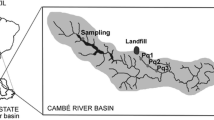Abstract
The state of natural and laboratory cladoceran populations under the effect of sodium lignosulfonate (the main component of waste waters of the Kondopoga pulp and paper mill (PPM) polluting the Onego Lake) was analyzed. An increase in the body length and fertility of Cladocera under the effect of sodium lignosulfonate was observed in long-term toxicological experiments. A hypothesis on the effect that this component has on the increased rise in Daphnia cristata Sars abundance, which changes the dynamics of its population, is proposed.
Similar content being viewed by others
References
Aivazyan, S.A., Enyukov, I.S., and Meshalkin, L.D., Prikladnaya statistika: issledovanie zavisimostei (Applied Statistics: Dependence Analysis), Moscow: Finansy i statistika, 1985.
Andronikova, I.N., Strukturno-funktsional’naya organizatsiya zooplanktona ozernykh ekosistem (Structural and Functional Organization of Zooplankton of Lake Ecosystems), St. Petersburg: Nauka, 1996.
Afanas’eva, N.I., Tel’tevskaya, S.E., Makarevich, N.A., and Parfenova, L.N., Struktura i fiziko-khimicheskie svoistva lignosul’fonatov (The Structure and Physicochemical Properties of Lignosulfonates), Yekaterinburg: Ural. Otd. Ross. Akad. Nauk, 2005.
Bezel’, V.S., Bol’shakov, V.N., and Vorobeichik, E.L., Populyatsionnaya ekotoksikologiya (Population Ecotoxicology), Moscow: Nauka, 1994.
Boitsova, T.A., Moshkova, T.B., and Afanas’ev, N.I., Study of the Biostimulatory Effect of Lignosulfonate Solutions after Microbiological Treatment, in Ekologiya-98: Tez. Dokl. (Abstracts of Papers, “Ecology-98”), Arkhangel’sk, 1998, p. 14.
Vislyanskaya, I.G., Structure and Dynamics of Phytoplankton Biomass, in Onezhskoe ozero. Ekologicheskie problemy (Onega Lake: Environmental Problems), Petrozavodsk: Izd. Karel. Nauch. Tsentra Ros. Akad. Nauk, 1999, pp. 146–157.
Gilyarov, A.M., Dinamika chislennosti presnovodnykh planktonnykh rakoobraznykh (The Population Dynamics of Freshwater Planktonic Crustaceans), Moscow: Nauka, 1987.
Gutel’makher, B.L., Metabolizm planktona kak edinogo tselogo: trofometabolicheskie vzaimodeistviya zoo- i fitoplanktona (Metabolism of Plankton as a Whole: Trophometabolic Interactions of Phytoplankton and Zooplankton), Leningrad: Nauka, 1986.
Zommer, E.A., Yan, N.A., Koroleva, L.A., et al., Ecological Toxicology of Lignic Compounds, Preprint of report, Baikal’sk: Baikal’sk. Filial Ekol. Toksikol. VNIIVO Goskomprirody SSSR, 1989.
Ivanova, M.B., Produktsiya planktonnykh rakoobraznykh v presnykh vodakh (Production of Planktonic Crustaceans in Freshwater), Leningrad: Zool. Inst. Akad. Nauk SSSR, 1985.
Kalinkina, N.M., Korosov, A.V., and Morozov, A.K., Estimation of the Critical Levels of Mineral Pollution of a River System with the Use of Simulation Ekologiya, 2005, vol. 36, no. 6, pp. 477–480.
Kulikova, T.P., Kustovlyankina, H.B., and Syarki, M.T., Zooplankton kak komponent ekosistemy Onezhskogo ozera (Zooplankton as a Component of the Onega Lake Ecosystem), Petrozavodsk: Izd. Karel’sk. Nauch. Tsentra Ros. Akad. Nauk, 1997.
Kulikova, T.P. and Syarki, M.T., Characteristics of the Structure and Function of Biological Communities under the Influence of Natural and Anthropogenic Factors. Structure and Quantitative Characteristics of Zooplankton, in Onezhskoe ozero. Ekologicheskie problemy (Lake Onega: Environmental Problems), Petrozavodsk: Izd. Karel. Nauch. Tsentra RAN, 1999, pp. 191–211.
Kulikova, T.P. and Syarki, M.T., Effect of Anthropogenic Eutrophication on Zooplankton Distribution in Kondopoga Bay of Lake Onega, Vodn. Resur., 2004, vol. 31, no. 1, pp. 91–97.
Metodicheskie rekomendatsii po sboru i obrabotke materialov gidrobiologicheskikh issledovanii na presnovodnykh vodoemakh. Zooplankton i ego produktsiya (Guidelines to Collection and Treatment of Materials of Hydrobiological Studies in Freshwater Bodies. Zooplankton and Its Production), Leningrad: Nauka, 1984.
Osipova, E.V., Zommer, E.A., Zubareva, L.D., and Koroleva, L.A., Effect of Sodium Lignosulfonate on Aquatic Animals, in Problemy Okhrany Prirody: Tez. Dokl. (Abstracts of Papers, “Nature Conservation Problems”), Baikal’sk, 1983, 39 p.
Pidgaiko, M.L., Zooplankton vodoemov Evropeiskoi chasti SSSR (Zooplankton of Water Bodies of the European Part of the USSR), Moscow: Nauka, 1984.
Prozorovskii, V.B. and Prozorovskaya, M.P., Table Method of Determination of ED50 (SL50) of Compounds with Low Biological Activity, Farmakol. Toksikol., 1980, no. 6, pp. 733–735.
Puzachenko, Yu.G., Matematicheskie metody v ekologicheskikh i geograficheskikh issledovaniyakh (Mathematical Methods in Ecological and Geographical Studies), Moscow: Izdat. Tsentr Akademiya, 2004.
Sabylina, A.V., Modern Hydrochemical Regime of the Lake, in Onezhskoe ozero. Ekologicheskie problemy (Lake Onega: Environmental Problems), Petrozavodsk: Izd. Karel. Nauch. Tsentra Ros. Akad. Nauk, 1999, pp. 58–108.
Stroganov, N.S., Method for Determination of Toxicity of Aquatic Medium, in Metodiki biologicheskikh issledovanii po vodnoi toksikologii (Methods of Biological Studies on Aquatic Toxicology), Moscow: Nauka, 1971, pp. 14–60.
Sushchenya, L.M., Semenchenko, V.P., Semenyuk, G.A., and Trubetskova, I.L., Produktsiya planktonnykh rakoobraznykh i faktory sredy (Production of Planktonic Crustaceans and Environmental Factors), Minsk: Nauka i tekhnika, 1990.
Syarki, M.T., Average Multiannual Seasonal Dynamics of Pelagic Plankton in Lake Onega, in Severnaya Evropa v XXI veke: priroda, kul’tura, ekonomika: Mater. mezhdunarod. konf. (Proc. Int. Conf. “Northern Europe in the XXI Century: Nature, Culture, and Economics”), Petrozavodsk, 2006, pp. 305–307.
Timakova, T.M., Bacterial Processes of Production and Destruction of Organic Matter, in Onezhskoe ozero. Ekologicheskie problemy (Lake Onega: Environmental Problems), Petrozavodsk: Izd. Karel. Nauch. Tsentra Ros. Akad. Nauk, 1999, pp. 174–190.
Shvarts, S.S., Methods of Introduction of Experimental Study Methods to Animal Ecology, in Ekologicheskie osnovy adaptatsii zhivotnykh: Tr. Moskov. Obshch. Ispyt. Prirody. Otd. Biol. Ural’sk. Otd. (Ecological Principles of Adaptation of Animals. Transact. Moscow Society of Nature Examiners, Biol. Div. Urals Branch), Moscow: Nauka, 1967, vol. 25, pp. 5–12.
Eckert, R., Rendell, D., and Ogastin, J., Fiziologiya zhivotnykh. Mekhanizmy i adaptatsiya (Animal Physiology: Mechanisms and Adaptation), Moscow: Mir, 1991 (Eckert R., Rondall D., and Augustine G., N.Y.: Freeman and Comp., 1988).
Author information
Authors and Affiliations
Corresponding author
Additional information
Original Russian Text © M.T. Syarki, N.M. Kalinkina, 2010, published in Biologiya Vnutrennikh Vod, No. 4, 2010, pp. 80–86.
Rights and permissions
About this article
Cite this article
Syarki, M.T., Kalinkina, N.M. Assessment of the effect that sodium lignosulfonate, the main component of wastewaters of pulp and paper industry, has on the state of natural and laboratory cladoceran populations. Inland Water Biol 3, 369–374 (2010). https://doi.org/10.1134/S1995082910040115
Received:
Published:
Issue Date:
DOI: https://doi.org/10.1134/S1995082910040115




